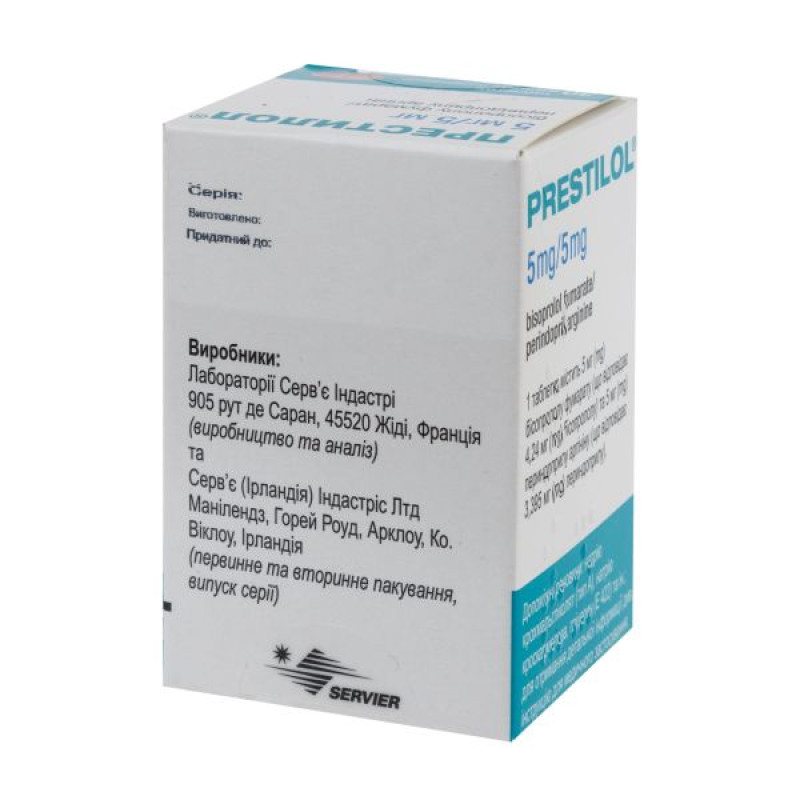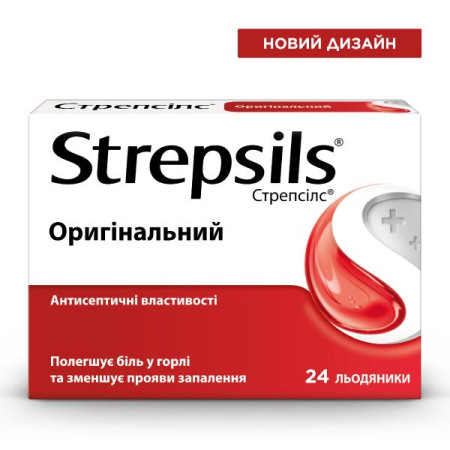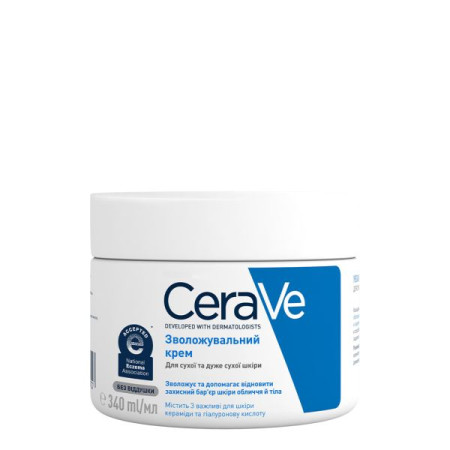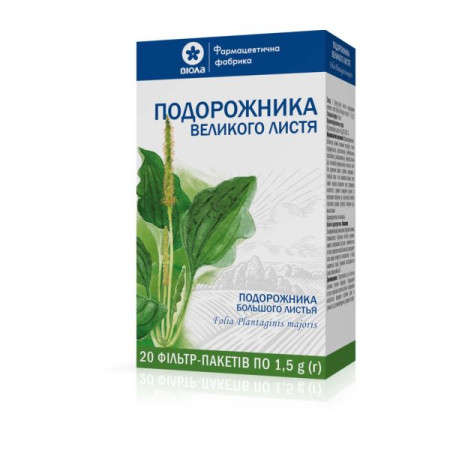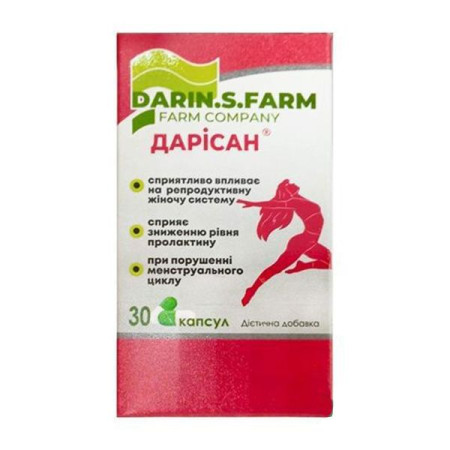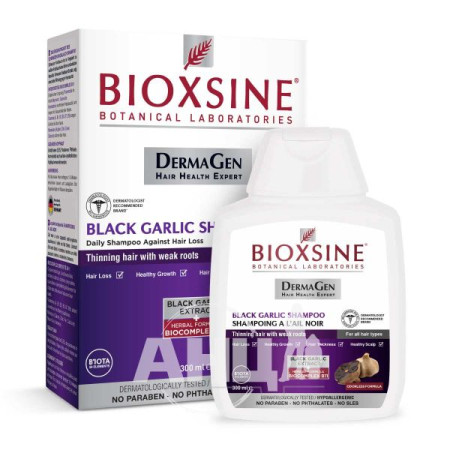Prestilol 5mg/5mg film-coated tablets 5 mg/5 mg container No. 30
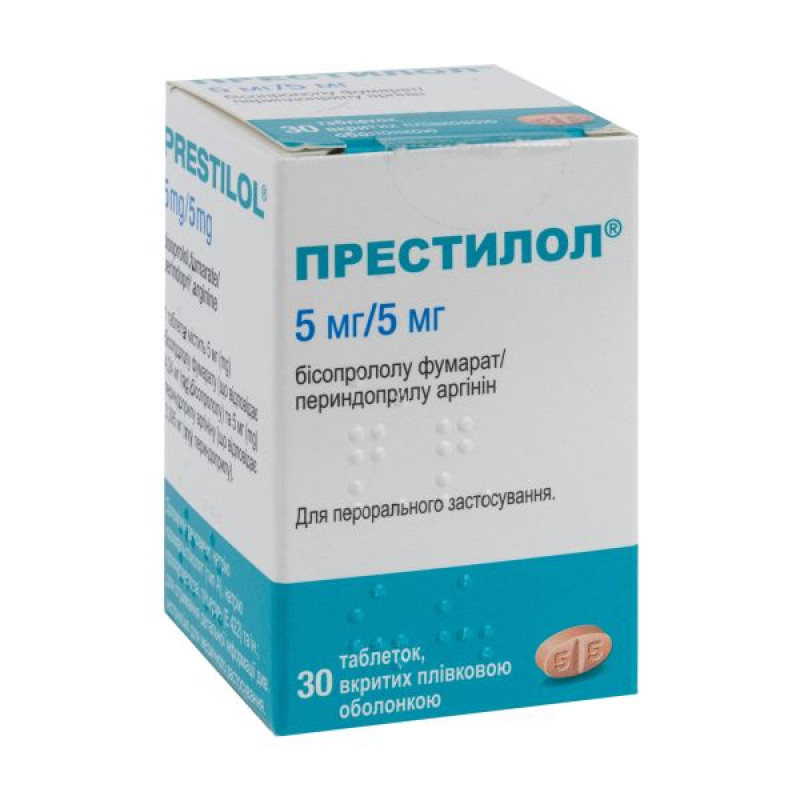
Instructions Prestilol 5mg/5mg film-coated tablets 5 mg/5 mg container No. 30
Composition
active ingredients: bisoprolol fumarate/perindopril arginine;
PRESTILOL® 5 mg/5 mg: 1 tablet contains 5 mg of bisoprolol fumarate (equivalent to 4.24 mg of bisoprolol) and 5 mg of perindopril arginine (equivalent to 3.395 mg of perindopril);
PRESTILOL® 5 mg/10 mg: 1 tablet contains 5 mg of bisoprolol fumarate (equivalent to 4.24 mg of bisoprolol) and 10 mg of perindopril arginine (equivalent to 6.790 mg of perindopril);
PRESTILOL® 10 mg/5 mg: 1 tablet contains 10 mg of bisoprolol fumarate (equivalent to 8.49 mg of bisoprolol) and 5 mg of perindopril arginine (equivalent to 3.395 mg of perindopril);
PRESTILOL® 10 mg/10 mg: 1 tablet contains 10 mg of bisoprolol fumarate (equivalent to 8.49 mg of bisoprolol) and 10 mg of perindopril arginine (equivalent to 6.790 mg of perindopril);
excipients: microcrystalline cellulose (type 102), calcium carbonate, pregelatinized starch (corn), sodium starch glycolate (type A), colloidal anhydrous silicon dioxide, magnesium stearate (E 470b), croscarmellose sodium;
film coating: glycerol (E 422), hypromellose (E 464), macrogol 6000, magnesium stearate (E 470b), titanium dioxide (E 171), yellow iron oxide (E 172), red iron oxide (E 172).
Dosage form
Film-coated tablets.
Main physicochemical properties:
PRESTILOL® 5 mg/5 mg: pink-beige, oblong film-coated tablet, scored and embossed with “ ” on one side and “5/5” on the other. The tablet can be divided into two parts.
PRESTILOL® 5 mg/10 mg: pink-beige, oblong film-coated tablet, scored and embossed with “ ” on one side and “5/10” on the other. The tablet is divisible into two parts.
PRESTILOL® 10 mg/5 mg: pink-beige, round film-coated tablet, embossed with “ ” on one side and “10/5” on the other.
PRESTILOL® 10 mg/10 mg: pink-beige, oblong film-coated tablet, embossed with “ ” on one side and “10/10” on the other.
Pharmacotherapeutic group
ACE inhibitors, other combinations. ATX code C09B X02.
Pharmacological properties
Pharmacodynamics.
Mechanism of action
Bisoprolol
Bisoprolol is a highly selective β1-adrenergic blocker that has no intrinsic sympathomimetic or pronounced membrane-stabilizing activity. It has low affinity for β2-receptors of bronchial and vascular smooth muscle, as well as for β2-receptors responsible for metabolic regulation. Therefore, bisoprolol should generally not affect airway resistance and β2-mediated metabolic effects. Its β1-selectivity extends beyond the therapeutic dosage range.
Perindopril
Perindopril is an inhibitor of the enzyme that converts angiotensin I to angiotensin II (angiotensin-converting enzyme (ACE)). The converting enzyme, or kinase, is an exopeptidase that enables the conversion of angiotensin I to the vasoconstrictor angiotensin II and also causes the breakdown of the vasodilator bradykinin to an inactive heptapeptide. Inhibition of ACE leads to a decrease in the concentration of angiotensin II in the blood plasma, which increases the activity of plasma renin (by inhibiting the negative feedback of renin release) and reduces the secretion of aldosterone. Since ACE inactivates bradykinin, inhibition of ACE also leads to an increase in the activity of the circulating and local kallikrein-kinin systems (and, thus, also leads to activation of the prostaglandin system). This mechanism of action is responsible for the blood pressure lowering effect of ACE inhibitors and is partly responsible for some of the side effects (e.g. cough). Perindopril acts through its active metabolite, perindoprilat. The other metabolites do not show activity in inhibiting ACE in vitro.
Pharmacodynamic effects
Bisoprolol
Bisoprolol does not exhibit a pronounced negative inotropic effect. The maximum effect of bisoprolol is achieved 3–4 hours after administration. Due to the half-life of 10–12 hours, bisoprolol retains its therapeutic effect for 24 hours. The maximum antihypertensive effect of bisoprolol is usually achieved after two weeks of administration. With a single administration in patients with ischemic heart disease without chronic heart failure, bisoprolol reduces heart rate and stroke volume and, thus, reduces cardiac output and oxygen consumption. With long-term administration, the initially increased peripheral resistance decreases. A decrease in plasma renin activity probably causes the antihypertensive effect of β-blockers. Bisoprolol reduces the sympathoadrenergic response by blocking β-adrenoreceptors of the heart, which causes a decrease in heart rate and contractility. This, in turn, leads to a decrease in myocardial oxygen consumption, which is necessary in the treatment of angina pectoris in ischemic heart disease.
Perindopril effectively reduces blood pressure in all degrees of arterial hypertension (mild, moderate and severe); a decrease in systolic and diastolic blood pressure is observed in the patient both in the supine and standing positions. Perindopril reduces peripheral vascular resistance, which leads to a decrease in blood pressure. As a result, peripheral blood flow increases without affecting heart rate. As a rule, renal blood flow also increases, while the glomerular filtration rate (GFR) is usually unchanged. The maximum antihypertensive effect develops 4-6 hours after taking a single dose and persists for at least 24 hours: the residual effect is about 87-100% of the peak effect. Blood pressure decreases rapidly. In patients who have responded to treatment, normalization of blood pressure occurs within a month and is maintained without the occurrence of tachyphylaxis. Discontinuation of treatment is not accompanied by a withdrawal effect. Perindopril reduces left ventricular hypertrophy. Clinical studies have shown that perindopril has vasodilating properties. It improves the elasticity of large arteries and reduces the ratio of wall thickness to lumen of small arteries. Perindopril reduces cardiac work by reducing pre- and afterload on the heart: reduces left and right ventricular filling pressure, reduces total peripheral vascular resistance, increases cardiac output and improves cardiac index (according to studies).
Pharmacokinetics.
The rate and extent of absorption of bisoprolol and perindopril in the composition of PRESTILOL® do not significantly differ from the rate and extent of absorption of bisoprolol and perindopril when used separately as monotherapy.
Bisoprolol
Absorption: Bisoprolol is almost completely (> 90%) absorbed from the gastrointestinal tract. The first-pass effect is insignificant (approximately 10%), which results in a high bioavailability (approximately 90%) after oral administration.
Distribution: The volume of distribution is 3.5 l/kg. The binding of bisoprolol to plasma proteins is about 30%.
Biotransformation and elimination. Bisoprolol is eliminated from the body by two routes. 50% is metabolized in the liver to inactive metabolites, which are then excreted by the kidneys, and the remaining 50% is excreted by the kidneys in an unmetabolized form. Total clearance is approximately 15 l/h. The plasma half-life is 10–12 hours, which provides a 24-hour effect after once-daily dosing.
Special patient groups. The kinetics of bisoprolol are linear and independent of age. Since bisoprolol is eliminated from the body to the same extent by the kidneys and liver, dose adjustment is not required in patients with impaired liver function or renal failure. Pharmacokinetics in patients with chronic heart failure and impaired liver or kidney function have not been studied. In patients with chronic heart failure (NYHA functional class III), bisoprolol plasma levels are higher and the half-life is longer compared to healthy volunteers. At a daily dose of 10 mg, the maximum plasma concentration in the steady state is 64 ± 21 ng/ml, and the half-life is 17 ± 5 hours.
Perindopril
Absorption: After oral administration, perindopril is rapidly absorbed, with peak plasma concentrations occurring within 1 hour. The plasma half-life of perindopril is 1 hour.
Distribution: The volume of distribution of unbound perindoprilat is approximately 0.2 l/kg. The binding of perindoprilat to plasma proteins is 20%, mainly to angiotensin-converting enzyme, and is dose-dependent.
Biotransformation. Perindopril is a prodrug. 27% of the administered dose of perindopril enters the bloodstream as the active metabolite perindoprilat. In addition to active perindoprilat, perindopril forms 5 more inactive metabolites. The maximum concentration of perindoprilat in the blood plasma is reached after 3–4 hours. Since food intake reduces the conversion of perindopril to perindoprilat, and therefore its bioavailability, perindopril arginine is recommended to be taken orally in a single daily dose in the morning before meals.
Excretion: Perindoprilat is excreted in the urine, with a terminal half-life of the unbound fraction of approximately 17 hours. Steady state is reached after 4 days.
Linearity: There is a linear relationship between the dose of perindopril and its plasma concentration.
Special patient groups. The elimination of perindoprilat is slowed down in elderly patients, as well as in patients with heart or renal failure. It is recommended to select the dose for patients with renal failure taking into account the degree of renal failure (creatinine clearance). The dialysis clearance of perindoprilat is 70 ml/min. The kinetics of perindopril are changed in patients with cirrhosis of the liver: the hepatic clearance of the parent molecule is halved. However, the amount of perindoprilat formed is not reduced. Therefore, no dose adjustment is required in such patients (see sections “Method of administration and dosage” and “Special precautions for use”).
Indication
PRESTILOL® 5 mg/10 mg and PRESTILOL® 10 mg/10 mg are indicated for the treatment of arterial hypertension and/or stable ischemic heart disease (with a history of myocardial infarction and/or revascularization) in adult patients who require therapy with bisoprolol and perindopril in doses available in a fixed combination.
PRESTILOL® 5 mg/5 mg and PRESTILOL® 10 mg/5 mg are indicated for the treatment of arterial hypertension and/or stable ischemic heart disease (with a history of myocardial infarction and/or revascularization), and/or stable chronic heart failure with reduced left ventricular systolic function in adult patients who require therapy with bisoprolol and perindopril in doses available in a fixed combination.
Contraindication
Hypersensitivity to the active substances or to any of the excipients or to any other ACE inhibitors;
acute heart failure or heart failure in the stage of decompensation requiring intravenous inotropic therapy;
cardiogenic shock;
atrioventricular block II or III degree (without an artificial pacemaker);
sick sinus syndrome;
sinoatrial block;
symptomatic bradycardia;
symptomatic arterial hypotension;
severe form of bronchial asthma or severe chronic obstructive pulmonary disease;
severe form of peripheral arterial occlusive disease or severe form of Raynaud's syndrome;
untreated pheochromocytoma (see section "Special instructions for use");
metabolic acidosis;
history of angioedema associated with previous ACE inhibitor therapy (see section "Special warnings and precautions for use");
hereditary or idiopathic angioedema;
pregnancy or planning a pregnancy (see section "Use during pregnancy or breastfeeding");
simultaneous use with drugs containing aliskiren in patients with diabetes mellitus or renal failure (GFR < 60 ml/min/1.73 m2) (see sections "Special instructions", "Interaction with other medicinal products and other types of interactions");
simultaneous use with sacubitril/valsartan. PRESTILOL® should not be used earlier than 36 hours after taking the last dose of sacubitril/valsartan (see sections “Special instructions for use” and “Interaction with other medicinal products and other types of interactions”);
extracorporeal treatments that result in blood coming into contact with negatively charged surfaces (see section “Interaction with other medicinal products and other types of interactions”);
significant bilateral renal artery stenosis or stenosis of the artery to a single functioning kidney (see section "Special warnings and precautions for use").
Interaction with other medicinal products and other types of interactions
In an interaction study conducted in healthy volunteers, no interaction was found between bisoprolol and perindopril. Information on interactions with other medicinal products for each active substance is provided below.
Drugs that increase the risk of angioedema. Concomitant use of ACE inhibitors with sacubitril/valsartan is contraindicated as it increases the risk of angioedema. Sacubitril/valsartan should not be initiated earlier than 36 hours after the last dose of perindopril. Perindopril therapy should not be initiated earlier than 36 hours after the last dose of sacubitril/valsartan (see sections 4.3 and 4.4).
Concomitant use of ACE inhibitors with racecadotril, mTOR inhibitors (e.g. sirolimus, everolimus, temsirolimus) and gliptins (e.g. linagliptin, saxagliptin, sitagliptin, vildagliptin) may lead to an increased risk of angioedema (see section 4.4).
Drugs causing hyperkalemia. Serum potassium levels are usually within normal limits, but hyperkalemia may occur in some patients taking PRESTILOL®. Some drugs (therapeutic classes of drugs) may increase the risk of hyperkalemia, including aliskiren, potassium salts, potassium-sparing diuretics (e.g. spironolactone, triamterene or amiloride), ACE inhibitors, angiotensin II receptor antagonists, non-steroidal anti-inflammatory drugs (NSAIDs), heparins, immunosuppressants such as ciclosporin or tacrolimus, trimethoprim and co-trimoxazole (trimethoprim/sulfamethoxazole), since trimethoprim acts as a potassium-sparing diuretic, similar to amiloride. Concomitant use of these drugs increases the risk of hyperkalemia. Therefore, the simultaneous use of PRESTILOL® with the above-mentioned drugs is not recommended. If concomitant use of these substances is necessary, they should be used with caution and serum potassium should be monitored frequently.
Concomitant use is contraindicated (see Contraindications section).
Extracorporeal treatments: Extracorporeal treatments that result in contact of blood with negatively charged surfaces, such as dialysis or haemofiltration using certain membranes with high hydraulic permeability (e.g. polyacrylonitrile) and low-density lipoprotein apheresis using dextran sulphate, are contraindicated due to the increased risk of severe anaphylactoid reactions (see section 4.3). If such treatments are necessary, consideration should be given to using a different type of dialysis membrane or a different class of antihypertensive agent.
Concomitant use is not recommended.
Interactions related to bisoprolol
Centrally acting antihypertensives such as clonidine and others (e.g. methyldopa, moxonidine, rilmenidine). Concomitant use with centrally acting antihypertensives may lead to worsening of heart failure due to decreased central sympathetic tone (decreased heart rate and cardiac output, vasodilation). Abrupt withdrawal of β-blocker therapy, particularly without prior dose reduction, may increase the risk of rebound hypertension.
Class I antiarrhythmic drugs (e.g. quinidine, disopyramide; lidocaine, phenytoin; flecainide, propafenone). Potentiation of the effect on atrioventricular conduction time and increased negative inotropic effect is possible.
Calcium antagonists of the verapamil group and to a lesser extent diltiazem. Negative effect on myocardial contractility and atrioventricular conduction. Intravenous administration of verapamil to patients taking β-blockers can lead to significant arterial hypotension and atrioventricular block.
Interactions related to perindopril
Aliskiren: In all other patients, as in patients with diabetes mellitus or patients with impaired renal function, the risk of hyperkalemia, worsening of renal function and cardiovascular disease and death is increased.
Concomitant use of ACE inhibitors and angiotensin receptor blockers: Clinical trial data have shown that dual blockade of the renin-angiotensin-aldosterone system (RAAS) through the concomitant use of ACE inhibitors, angiotensin II receptor blockers or aliskiren increases the risk of adverse reactions such as hypotension, hyperkalaemia and worsening of renal function (including acute renal failure) compared to the use of a single RAAS-acting agent (see sections 4.3 and 4.4). In patients with established atherosclerosis, heart failure, or diabetes mellitus with target organ damage, concomitant therapy with an ACE inhibitor and an angiotensin receptor blocker has been reported to be associated with an increased incidence of hypotension, syncope, hyperkalemia, and worsening renal function (including acute renal failure) compared with the use of a single agent acting on the renin-angiotensin-aldosterone system. Dual blockade (i.e., the combination of an ACE inhibitor and an angiotensin II receptor antagonist) may be considered in individual cases and with close monitoring of renal function, potassium levels, and blood pressure.
Estramustine: There is a risk of increased adverse reactions, including angioedema.
Potassium-sparing diuretics (e.g. triamterene, amiloride), potassium salts. Hyperkalaemia (possibly fatal), especially in patients with renal insufficiency (additive hyperkalaemia effect). The above-mentioned drugs are not recommended for concomitant use with perindopril (see section 4.4). However, if concomitant use of these substances is necessary, they should be used with caution and with frequent monitoring of serum potassium. For the use of spironolactone in heart failure, see below.
Lithium: Reversible increases in serum lithium concentrations and increased toxicity have been reported with concomitant use of ACE inhibitors. Concomitant use of perindopril and lithium is not recommended. However, if such a combination is considered necessary, serum lithium concentrations should be closely monitored (see section 4.4).
Concomitant use requiring special attention
Interactions related to bisoprolol and perindopril
Non-steroidal anti-inflammatory drugs (NSAIDs), including acetylsalicylic acid in doses ≥ 3 g/day. With the simultaneous use of PRESTILOL® with NSAIDs (such as acetylsalicylic acid in anti-inflammatory doses, cyclooxygenase COX-2 inhibitors and non-selective NSAIDs), the antihypertensive effect of bisoprolol and perindopril may be reduced. In addition, the simultaneous use of ACE inhibitors and NSAIDs may increase the risk of worsening renal function, including possible acute renal failure, and increase the level of potassium in the blood, especially in patients with pre-existing impaired renal function. Such a combination should be prescribed with caution, especially in elderly patients. Patients should be rehydrated and consideration should be given to monitoring renal function after starting combination therapy and during subsequent treatment.
Antihypertensive drugs and vasodilators: Concomitant use with antihypertensive drugs, vasodilators (e.g. nitroglycerin, other nitrates or other vasodilators) or with other drugs that may lower blood pressure (e.g. tricyclic antidepressants, barbiturates, phenothiazines) may increase the risk of hypotensive effects of perindopril and bisoprolol.
Tricyclic antidepressants/antipsychotics/anaesthetics. Concomitant use of ACE inhibitors and some anaesthetics, tricyclic antidepressants and antipsychotics may lead to a further decrease in blood pressure. Concomitant use of bisoprolol with anaesthetics may lead to an attenuation of reflex tachycardia and an increased risk of hypotension.
Sympathomimetics. β-sympathomimetics (e.g. isoprenaline, dobutamine): Concomitant use with bisoprolol may reduce the effects of both drugs. Sympathomimetics that activate α- and β-adrenoceptors (e.g. norepinephrine, epinephrine): Combination with bisoprolol may potentiate the α-adrenoceptor-mediated vasoconstrictor effects of these drugs, leading to an increase in blood pressure and exacerbation of intermittent claudication. Such interactions are more likely with non-selective β-blockers. Sympathomimetics may reduce the antihypertensive effects of ACE inhibitors.
Interactions related to bisoprolol
Dihydropyridine calcium antagonists such as felodipine and amlodipine. Concomitant use may increase the risk of hypotension; an increased risk of further deterioration of ventricular pumping function in patients with heart failure cannot be excluded.
Class III antiarrhythmic drugs (e.g. amiodarone). Possible increased effect on atrioventricular conduction time.
Parasympathomimetic drugs: Concomitant use may increase atrioventricular conduction time and the risk of bradycardia.
Topical ß-blockers (e.g. eye drops for the treatment of glaucoma). Concomitant use may enhance the systemic effects of bisoprolol.
Digitalis glycosides. Decreased heart rate, increased atrioventricular conduction time.
Interactions related to perindopril
Baclofen. Enhances the antihypertensive effect. Blood pressure should be monitored and the dose adjusted if necessary.
Diuretics. In patients taking diuretics, especially in case of impaired water and electrolyte metabolism, an excessive decrease in blood pressure is possible after starting treatment with an ACE inhibitor. The likelihood of developing a hypotensive effect is reduced if the diuretic is discontinued, the circulating blood volume is increased or salt intake is increased before starting therapy, which should be started at low doses with a gradual increase in the dose of perindopril. In arterial hypertension, when the previously prescribed diuretic could have caused water/electrolyte depletion, it should be discontinued before starting treatment with an ACE inhibitor (in such cases, the diuretic can be resumed over time) or treatment with an ACE inhibitor should be started at low doses with a gradual increase in the dose. In congestive heart failure on the background of taking a diuretic, the use of an ACE inhibitor should be started at a low dose, possibly after reducing the dose of the concomitant diuretic. In all cases, renal function (creatinine level) should be monitored during the first weeks of treatment with an ACE inhibitor.
Potassium-sparing diuretics (eplerenone, spironolactone). Concomitant use of eplerenone or spironolactone at doses of 12.5 mg to 50 mg per day with low doses of ACE inhibitors: if the recommendations for the appointment of such a combination are not followed, there is a risk of hyperkalemia (possibly fatal) during the treatment of patients with NYHA class II-IV heart failure and an ejection fraction < 40%, who were previously treated with an ACE inhibitor and a loop diuretic. Before prescribing such a combination, it is necessary to ensure the absence of hyperkalemia and renal insufficiency. It is recommended to carefully monitor potassium and creatinine weekly during the first month of treatment and monthly thereafter.
Concomitant use requiring attention
Interactions related to bisoprolol
Mefloquine: Increased risk of bradycardia.
Interactions related to perindopril
Gold: Concomitant use of ACE inhibitors, including perindopril, and injectable gold (sodium aurothiomalate) may rarely cause reactions similar to those seen with nitrates (symptoms: flushing, nausea, vomiting, and hypotension).
Application features
All warnings associated with each of the components of the drug apply to the drug PRESTILOL®.
Hypersensitivity/angioedema. Rare cases of angioedema of the face, extremities, lips, mucous membranes, tongue, glottis and/or larynx have been reported in patients taking ACE inhibitors, including perindopril (see section 4.8). This may occur at any time during treatment. In such cases, PRESTILOL® should be discontinued immediately. β-blocker therapy should be continued. Appropriate monitoring of the patient's condition should be established until complete resolution of symptoms. In cases where the swelling is limited to the face and lips, the patient's condition usually improves without treatment, but antihistamines may be useful in reducing symptoms. Angioedema associated with laryngeal edema can be fatal. If the swelling extends to the tongue, glottis or larynx, which may lead to airway obstruction, emergency treatment should be initiated immediately, which may include the administration of adrenaline and/or maintenance of a patent airway. The patient should be kept under close medical supervision until complete and sustained resolution of symptoms. Patients with a history of angioedema unrelated to ACE inhibitor therapy are at increased risk of developing angioedema (see section 4.3). Rare cases of intestinal angioedema have been reported in patients treated with ACE inhibitors. These patients have presented with abdominal pain (with or without nausea and vomiting); in some cases, there was no previous history of facial angioedema and C-1 esterase levels were normal. The diagnosis of intestinal angioedema was made by computed tomography or ultrasound or during surgery. After discontinuation of the ACE inhibitor, the symptoms of angioedema disappeared. Intestinal angioedema should be considered in the differential diagnosis of abdominal pain in patients taking ACE inhibitors. The concomitant use of perindopril with sacubitril/valsartan is contraindicated due to an increased risk of angioedema (see section 4.3). Sacubitril/valsartan should not be started earlier than 36 hours after the last dose of perindopril. If treatment with sacubitril/valsartan is discontinued, perindopril therapy should be initiated no earlier than 36 hours after the last dose of sacubitril/valsartan (see sections 4.3 and 4.5). Concomitant use of ACE inhibitors with neutral endopeptidase (NEP) inhibitors (e.g. racecadotril), mTOR inhibitors (e.g. sirolimus, everolimus, temsirolimus) and gliptins (e.g. linagliptin, saxagliptin, sitagliptin, vildagliptin) may lead to an increased risk of angioedema (e.g. swelling of the airways or tongue, with or without respiratory impairment) (see section 4.5). Caution should be exercised when initiating treatment with racecadotril, mTOR inhibitors (e.g. sirolimus, everolimus, temsirolimus) and gliptins (e.g. linagliptin, saxagliptin, sitagliptin, vildagliptin) in patients already taking ACE inhibitors.
Hepatic impairment. Rarely, ACE inhibitors have been associated with a syndrome that begins with cholestatic jaundice and progresses to transient hepatic necrosis, sometimes fatal. The mechanism of this syndrome is unknown. Patients who develop jaundice or marked elevations of hepatic enzymes while taking ACE inhibitors should discontinue the ACE inhibitor and receive appropriate medical evaluation and treatment (see section 4.8).
Race: ACE inhibitors cause angioedema more frequently in black patients than in non-black patients. As with other ACE inhibitors, perindopril is less effective in lowering blood pressure in black hypertensive patients than in non-black patients, possibly because of lower renin status in these patients.
Hyperkalemia. Some patients have experienced increases in serum potassium while taking ACE inhibitors, including perindopril. ACE inhibitors can cause hyperkalemia because they inhibit the release of aldosterone. In patients with normal renal function, this effect is usually insignificant. Risk factors for hyperkalemia include: renal failure, worsening renal function, age > 70 years, diabetes mellitus, intercurrent conditions such as dehydration, acute cardiac decompensation, metabolic acidosis, and concomitant use of potassium-sparing diuretics (such as spironolactone, eplerenone, triamterene or amiloride), potassium supplements or potassium-containing salt substitutes; or other drugs that increase serum potassium (including heparin, co-trimoxazole, also known as trimethoprim/sulfamethoxazole) and especially aldosterone antagonists or angiotensin receptor blockers. The use of potassium supplements, potassium-sparing diuretics or salt substitutes containing potassium, especially in patients with impaired renal function, may lead to significant increases in serum potassium. Hyperkalemia may cause serious, sometimes fatal arrhythmias. Potassium-sparing diuretics and angiotensin receptor blockers should be used with caution in patients taking ACE inhibitors, and serum potassium and renal function should be closely monitored. If concomitant use of perindopril and any of the above-mentioned substances is considered appropriate, such use should be undertaken with caution and frequent monitoring of serum potassium levels (see section 4.5).
Combinations with lithium: The concomitant use of lithium and perindopril is generally not recommended (see section 4.5).
There are no reviews for this product.
There are no reviews for this product, be the first to leave your review.
No questions about this product, be the first and ask your question.








